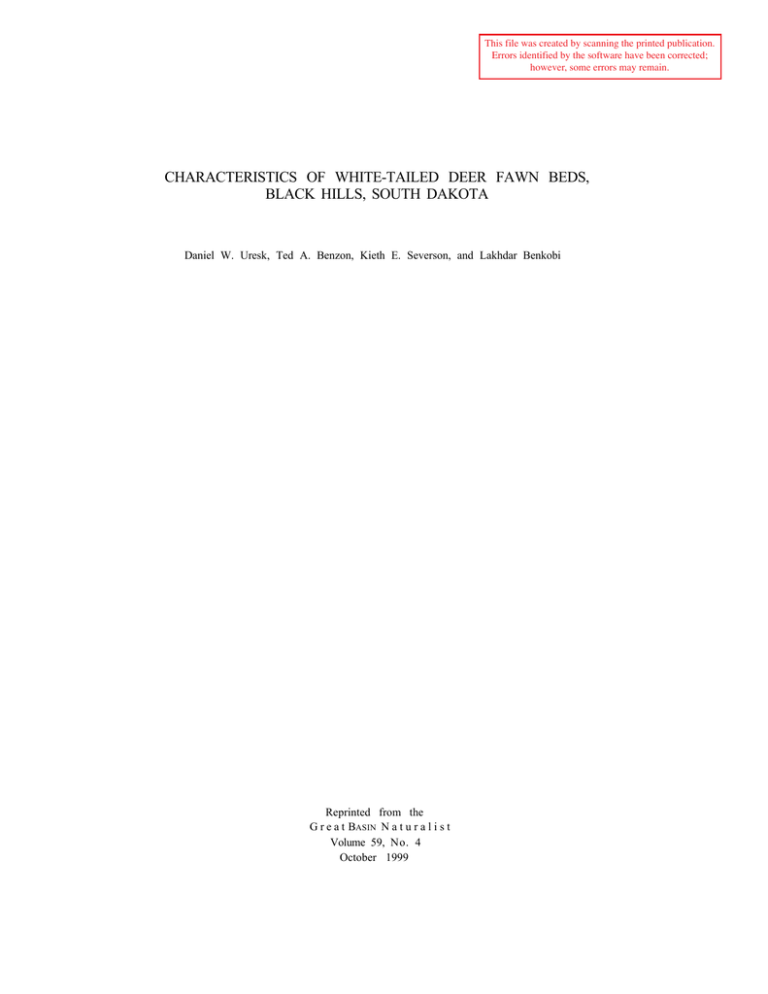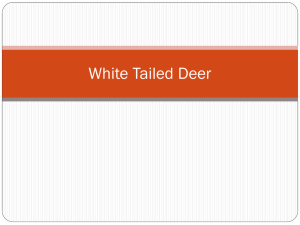This file was created by scanning the printed publication.
advertisement

This file was created by scanning the printed publication. Errors identified by the software have been corrected; however, some errors may remain. CHARACTERISTICS OF WHITE-TAILED DEER FAWN BEDS, BLACK HILLS, SOUTH DAKOTA Daniel W. Uresk, Ted A. Benzon, Kieth E. Severson, and Lakhdar Benkobi Reprinted from the G r e a t BASIN N a t u r a l i s t Volume 59, No. 4 October 1999 Great Basin Naturalist 59(4), 01999, pp. 348-354 CHARACTERISTICS OF WHITE-TAILED DEER FAWN BEDS, BLACK HILLS, SOUTH DAKOTA Daniel W. Uresk 1, Ted A. Benzon 2 , Kieth E. Severson 1 , and Lakhdar Benkobi 3 Abstract. - Forty-two white-tailed deer fawns (Odocoileus virginianus dakotensis) were captured and fitted with radio transmitters and observed from June through September 1991 and 1992 to determine diurnal bed site use in the Black Hills of South Dakota. Fawns were monitored biweekly during daylight hours and 259 bed sites were located. In addition, 301 random sites were measured for comparison. Of 31 habitat variables measured, 8 were significant to determine use by fawns for a bed site when compared with random sites. Sites used by fawns were in relatively open stands of ponderosa pine (Pinus ponderosa) with mean basal area of approximately 11 m2/ha compared to 16 m2/ha in random sites. Fawn bed sites had greater mean vegetation cover, which ranged from 28.1% to 36.0%, compared with 19.9% and 33.8% at random sites in 1991 and 1992, respectively. Mean vegetation height was 101 cm at bed sites compared to 75 cm at random sites. Current timber harvest standards for stocking levels of pine range from 14 m2/ha to 18 m2/ha in the Black Hills, which are similar to our random sites. These levels preclude adequate development of understory characteristics used by white-tailed deer fawns for bed sites. Key words: white-tailed deer, Odocoileus virginianus dakotensis, fawns, bed sites, habitat, derosa pine, Black Hills. Winter often is considered the most critical time for many cervid populations in northern North America, and most earlier habitat research has emphasized winter range. Whitetailed deer (Odocoileus virginianus dakotensis) in the Black Hills are no exception; conditions on winter range are critical to these migratory populations (Seig and Severson 1996). There is, however, a growing awareness that conditions on northern summer ranges may be equally important, particularly those relating to types and quality of habitat available to lactating females and their fawns. Spring and summer habitat use patterns of adult females have been examined in the Black Hills (Kennedy 1992, Stefanich 1995, Deperno 1998), but fawn bed site use has not been studied. A fawn’s choice of bed site is limited to the general area (macrohabitat) chosen by the doe. Although specifics for white-tailed deer are sparse, studies on other ungulates suggest the actual bed site is selected by the fawn (Marchinton and Hirth 1984, Huegel et al. 1986). Bed site location is critical to fawn survival because as neonates fawns spend most of their time lying down, often at a considerable distance from dams (Schwede et al. 348 herbaceous cover, pon- 1994). Cover at bed sites functions to hide deer from predators and to provide thermal cover (Huegel et al. 1986, Hyde et al. 1987). The objective of this study was to examine habitat characteristics of white-tailed deer fawn bed sites to develop effective habitat management guidelines. The null hypothesis tested was that there are no differences in selected vegetative and physical attributes between fawn bed sites and randomly selected sites. Study AREA The study was conducted in the northeastern Black Hills, South Dakota. The area includes about 39,000 ha, most of which is administered b y U.S. Forest Service, Black Hills National Forest, although private lands are interspersed throughout. It is bounded by Interstate 90 on the east, U.S. Highway 14A on the north, U.S. Highway 385 on the west, and Nemo Road on the south. Elevations range from 1068 m to 1677 m. Average annual precipitation ranges from 422 mm at Rapid City, just southeast of the study area, to 737 mm at Deadwood on the northwest. 1999] W H I T E - TAILED F A W N B ED S I T E S , BLACK H ILLS Average monthly temperatures during the coldest and warmest months (February and August) are -7.7o and 21.9oC at Rapid City and -8.8o and 16.1oC at Deadwood (NOAA 1994). The study area is dominated by ponderosa pine (Pinus ponderosa) forest. The prevailing habitat type is ponderosa pine / snowberry / bearberry (Pinus ponderosa / Symphoricarpos albus /Arctostaphylos uva-ursi), as described by Thilenius (1972). White spruce (Picea glauca) with scattered stands of aspen (Populus tremuloides) occur sparingly on lower portions of north-facing slopes. Aspens also are found as stringers within upper drainages and often form a border between the ponderosa pine forest and riparian meadows. These meadows, dominated by Kentucky bluegrass (Poa pratensis) and mostly privately owned, were grazed by cattle and horses and/or hayed. National forest lands were grazed by cattle. Harvest of ponderosa pine, primarily by seed tree cuts or overstory removal, has been conducted throughout the study area. METHODS Capturing and Monitoring Fawns White-tailed deer fawns were located via ground searches using doe behavior as an indicator of fawn presence (Huegel et al. 1985). Initial fawn searches encompassed the entire study area. Captured fawns were fitted with radio transmitters attached to expandable break-away collars. Total weight of transmitter and collar was 165 g. Collars were colored brown to match fawn pelage, and for 2 wk prior to placement they were stored in plastic bags containing fresh vegetation and/or pine needles. Handlers wore vinyl gloves during capture and collaring activities. A total of 28 male and 14 female fawns were captured and fitted with radio transmitters over the 2-yr period. We monitored individual fawns during daylight hours every other week. Observations of 22 fawns began on 9 June 1991, and of 20 fawns 15 June 1992, ending 28 September 1991 and 21 September 1992. Vegetation was measured on a biweekly basis corresponding to fawn bed site location. Once bed sites were located, we marked the area and took vegetation measurements the following day. Microhabitat Measurements Microhabitat measurements were taken at all fawn bed sites and at random sites within 349 the study area. Random sites were selected by computer-generated random numbers (Universal Transverse Mercator coordinates) within each section of the study area. Using a 10-factor prism, we estimated tree basal area (BA) at each bed and random site center (Sharpe et al. 1976). Canopy cover of shrubs, grasses, and forbs, all by species, was estimated in twenty-four 0.1-m2 quadrats (Daubenmire 1959) spaced at l-m intervals along 2 perpendicular transects crossing at bed or random site center. Percent of area covered by slash, litter, rock, and bare ground was estimated in the same plots. We used a modified Robel pole with 2-cm alternating orange and white bands to estimate height density (based on visual obstruction, VOR) of understory vegetation (Robel et al. 1970). The pole was placed at bed/random site center and at 4 evenly spaced locations (90o) 2 m from center. Readings were taken at 4 evenly spaced locations (90o) around each pole for a total of 20 observations at each site. The 4 observations around the pole were read from a distance of 4 m at a height of 1 m. Following the same procedure, we used a 250-cm pole to estimate vegetation height. Overstory canopy cover was estimated using a spherical densiometer at site center and at the end of each transect for a total of 5 observations. Statistical Analysis We reduced data collected from each fawn bed and random site to 1 mean per attribute per site, for a total of 31 habitat variables. Data were examined for heterogeneous variances using Bartlett’s test. When heterogeneous variances were detected, data were log10 transformed. Averages of bed and random sites were compared using multivariate testing of hypothesis based on centered bootstrap adjusted P-values (Wright 1992). Data could have been analyzed for each variable separately, but our concern was correlations among variables for the same observation. More specifically, the Pvalue produced in separate tests could be correlated, likely causing an incorrect declaration of significance in some cases. The multitest adjusts P-values to account for multiple correlation. We examined the variables year (1991, 1992), biweekly intervals (1-8), type (fawn, random), and interactions to test the hypothesis that fawn bed sites do not differ from random 354 [Volume 59 GREAT B ASIN NATURALIST LITERATURE CITED R OBEL, R.J., J.N. BRIGGS, A.D. DAYTON, AND L.C. HURL1970. Relationships between visual obstruction measurements and weight of grassland vegetation. Journal of Range Management 23:295-297. SCHWEDE, G., H. HENDRICHS, AND C. WEMMER . 1994. Early mother-young relations in white-tailed deer. Journal of Mammalogy 75:438-445. SEIG, C.H., AND K.E. S EVERSON, 1996. Managing habitats for white-tailed deer: Black Hills and Bear Lodge Mountains of South Dakota and Wyoming. U.S. Forest Service, General Technical Report RM-274. SHARPE, G.W., C.W. HENDEE, AND SW. ALLEN. 1976. Introduction to forestry. McGraw-Hill Company, New York. 544 pp. STEFANICH, M.R. 1995. Movements and habitat use patterns of white-tailed deer in the northwestern Black Hills of Wyoming. Master’s thesis, University of Wyoming, Laramie. 46 pp. THILENIUS, J.F. 1972. Classification of deer habitat in the ponderosa pine forest of the Black Hills. U.S. Forest Service Research Paper RM-91. URESK, D.W., AND K.E. SEVERSON. 1989. Understoryoverstory relationships in ponderosa pine forests, Black Hills, South Dakota. Journal of Range Management 42:203-208. -.1998. Managing species in the understory of ponderosa pine in the Black Hills. Great Basin Naturalist 58:312-327. WRIGHT, S.P. 1992. Adjusted P-values for simultaneous inference. Biometrics 48:1005-1013. BERT. BLACK HILLS NATIONAL FOREST. 1983. Land and resource management plan. U.S. Forest Service, Black Hills National Forest, Custer, SD. DAUBENMIRE, R. 1959. A canopy-coverage method of vegetation analysis. Northwest Science 33:43-64. DEPERNO C.S. 1998. Habitat selection of a declining whitetailed deer herd in the central Black Hills, South Dakota and Wyoming. Doctoral dissertation, South Dakota State University, Brookings. 185 pp. HUEGEL, C.N. 1985. Predator-avoidance behaviors in white-tailed deer that favor fawn survival. Doctoral dissertation, Iowa State University, Ames. 150 pp. HUEGEL, C.N., R.B. DAHLGREN, AND H.L. GLADFELTER 1985. Use of doe behavior to capture white-tailed deer fawns. Wildlife Society Bulletin 13:287-289. ____.1986. Bedsite selection by white-tailed deer fawns in Iowa. Journal of Wildlife Management 50:474-480. HYDE, K.J., C.A. DeYoung, AND A. Garza, JR. 1987. Bed sites of white-tailed deer fawns in south Texas. Proceedings of the Annual Conference, Southeastern Association of Fish and Wildlife Agencies 41:288-293. KENNEDY, J.F. 1992. Habitat selection by female whitetailed deer in the northern Black Hills, South Dakota and Wyoming. Master’s thesis, South Dakota State University, Brookings. 65 pp. MARCHINTON, R.L., AND D.H. HIRTH. 1984. Behavior. Pages 129-168 in L.K. Halls, editor, White-tailed deer ecology and management. Wildlife Management Institute, Washington, DC, and Stackpole Books, Harrisburg, PA. NOAA. 1994. Climatological data annual summary. National Oceanic and Atmospheric Administration, National Climatic Data Center, Asheville, NC. Received 13 April 1998 Accepted 6 January 1999

![[Clinic newsletter] - MSD Animal Health New Zealand](http://s3.studylib.net/store/data/007623488_2-57a0ccefba0719f75b5176091a508533-300x300.png)

